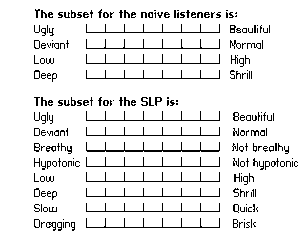Perceptual evaluations

Depending on the goal of the evaluations, they can be carried out either by naive listeners or by experienced SLPs who are trained for doing these perceptual evaluations. Results have shown that a minimal basic subset of 4 perceptual scales covers the two underlying perceptual dimension (voice quality and pitch) found for the naive raters sufficiently, and that for the SLPs a minimal basic subset of 8 perceptual scales is sufficient to cover the 4 underlying perceptual dimensions (voice quality, tonicity, pitch, and tempo) found for them. (Van As, 2001). The perceptual scales used, consist of semantic bipolar 7-point scales. The instruction given to the listeners is to choose the extreme scale ends (1 or 7) when the term is very much applicable to the voice quality, to choose one interval more towards the middle (2 or 6) when the term is moderately applicable, one interval more to the middle (3 or 5) when the term is a little applicable, and the middle (4) when both terms are equally or neither one of the terms is applicable.
Also a number of other perceptual scales such as bubbly-not bubbly, unsteady-steady, weak-powerful, and monotonous-melodious are suitable for perceptual evaluation of tracheoesophageal speech. These scales can be added to the minimal subset, depending on the purpose of the perceptual evaluations. Apart from the perceptual scale judgments, it is also advised to judge the overall voice quality as good, reasonable, or poor. A good voice is defined as “almost similar to normal voice”, a poor voice is defined as “very deviant from normal voice”, and reasonable voice is defined as “somewhere in between both extremes”.
Although perceptual evaluations are straightforward and clinically relevant it also has some disadvantages. They are subjective, time-consuming, and listeners might differ in their opinion. Acoustic analysis does solve some of these problems, but also has some major disadvantages in analyzing tracheoesophageal voice.
Although perceptual evaluations are straightforward and clinically relevant it also has some disadvantages. They are subjective, time-consuming, and listeners might differ in their opinion. Acoustic analysis does solve some of these problems, but also has some major disadvantages in analyzing tracheoesophageal voice.